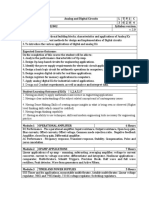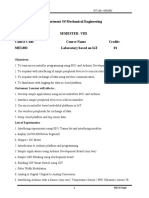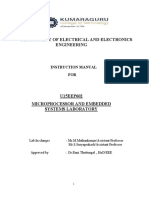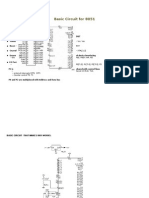0 ratings0% found this document useful (0 votes)
66 viewsSyllabus Microcontroller
Uploaded by
Harini M 19BEE1098Copyright
© © All Rights Reserved
Available Formats
Download as PDF, TXT or read online on Scribd
0 ratings0% found this document useful (0 votes)
66 viewsSyllabus Microcontroller
Uploaded by
Harini M 19BEE1098Copyright
© © All Rights Reserved
Available Formats
Download as PDF, TXT or read online on Scribd
You are on page 1/ 3
Course code Course title L T P J C
ECE3003 MICROCONTROLLER AND ITS APPLICATIONS 2 0 2 4 4
Pre-requisite ECE2003 - Digital Logic Design Syllabus version
v. xx.xx
Course Objectives:
1. To acquaint students with architectures of microprocessors, microcontroller and ARM
processors
2. To familiarize the students with assembly language programming in 8051 microcontroller
3. To design and implementation of peripherals interfacing to the 8051 microcontroller
4. To introduce the students to the code converters interfacing and sensors interfacing with
8051 microcontroller
Expected Course Outcome:
At the end of the course, the student should be able to
1. Comprehend and analyze architectures of microprocessors, microcontroller and ARM7
processor
2. Comprehend the evaluations of the Intel (i3, i5, i7) series processors
3. Comprehend the memory organization of 8051 microcontroller
4. Showcase the skill, knowledge and ability of programming using instruction set
5. Work with microcontroller and interfaces including general purpose input/ output and
timers
6. Comprehend and use peripheral serial communication and the concepts of interrupts in
8051 microcontroller
7. Interface 8051 microcontroller with the input and output devices such as LEDs, LCDs, 7-
segment display and keypad
8. Design 8051 microcontroller based system with analog-to-digital converters and digital-to-
analog converters within realistic constraints like user specification, availability of
components etc.
Student Learning Outcomes (SLO): 2, 14, 17
2. Having a clear understanding of the subject related concepts and of contemporary issues
14. Having an ability to design and conduct experiments, as well as to analyze and interpret
data
17. Having an ability to use techniques, skills and modern engineering tools necessary for
engineering practice
Module:1 Introduction to Processors: 4 hours CO: 1,2
Introduction to Microprocessors and Microcontrollers, 8-bit/16-bit Microprocessor Architectures
[8085, 8086], Introduction to ARM7, Intel I (i3, i5, i7) Series Processors
Module:2 8051 Architecture: 4 hours CO: 3
8051 - Organization and Architecture, RAM-ROM Organization, Machine Cycle
Module:3 8051 Instruction Set: 6 hours CO: 4
Data Processing - Stack, Arithmetic, Logical; Branching – Unconditional and Conditional
Module:4 8051 Peripherals: Ports and Timers 3 hours CO: 5
Peripherals: I/O Ports, Timers-Counters
Module:5 8051 Peripherals: Serial Communication and 3 hours CO: 6
Interrupt
Peripherals: Serial Communication, Interrupts
Module:6 Peripheral Interfacing: 4 hours CO: 7
Interfaces: LCD, LED, Keypad
Module:7 Peripheral Interfacing: 4 hours CO: 8
Interfaces: Analog-to-Digital Convertors, Digital-to-Analog Convertors, Sensor with Signal
Conditioning Interface
Module:8 Contemporary issues: 2 hours
Total Lecture hours: 30 hours
Text Book(s)
1. Mohammad Ali Mazidi, Janice G. Mazidi, Rolin D. McKinlay, “The 8051 Microcontroller
and Embedded Systems”, 2014, Pearson, India.
Reference Books
1. Muhammad Ali Mazidi, Rolin D. McKinlay, Janice G. Mazidi, “The 8051 Microcontroller: A
Systems Approach”, 2012, First Edition, Pearson, India.
2. A. Nagoor Kani, “8086 Microprocessors and its Applications”, 2012, Second Edition, Tata
McGraw-Hill Education Pvt. Ltd., New Delhi, India.
3. Joseph Yiu, “The Definitive Guide to ARM® Cortex®-M0 and Cortex-M0+ Processors”,
2015, 2nd Edition, Elsevier Science & Technology, UK
Mode of Evaluation: CAT / Assignment / Quiz / FAT / Project / Seminar
List of Challenging Experiments (Indicative) CO: 4,5,6,7,8
1 Keil Simulator tool Introduction. 2 hours
2 I/O ports programming. 4 hours
3 LCD Interfacing. 2 hours
4 Keypad Interfacing. 2 hours
5 Timer programming. 4 hours
6 Interrupt Programming. 4 hours
7 Motor Interfacing. 2 hours
8 ADC/DAC Interfacing. 4 hours
9 Sensors Interfacing. 4 hours
10 Serial port programming. 2 hours
Total Laboratory Hours 30 hours
Typical Projects: SLO: 17
1. Electronic code locker
2. Water level Indicator alarm
3. Remote Room Temperature Monitoring
4. Digital countdown timer
5. Fire detection
6. Digital voltmeter
7. Car parking system
8. Vehicle tracking system
9. TV Remote control
10. Intelligent Traffic control
11. Smartphone home appliance control
12. Automated toll collection system
13. Sun tracking system
14. Street light intensity control
15. Rash driving alert
16. Flood monitoring
17. Automatic irrigation system
18. GSM based energy monitoring system
19. Gas leakage detection
20. Electronic Voting Machine
21. Automatic College Bell
22. Finger print based Electronic Voting Machine
23. Line Following Robot
24. Microcontroller based Intelligent Digital Volume Controller with Timers
Mode of evaluation: Review I, II and III
Recommended by Board of Studies DD-MM-YYYY
Approved by Academic Council No. xx Date DD-MM-YYYY
CO – SLO mapping
Module CO SLO
1 1,2 2
2 3 2
3 4 14
4 5 14
5 6 14
6 7 14
7 8 14
You might also like
- The 8051 Microcontroler Based Embedded Systems0% (1)The 8051 Microcontroler Based Embedded Systems43 pages
- BECE320E_EMBEDDED-C-PROGRAMMING_ETH_1.0_0_BECE320ENo ratings yetBECE320E_EMBEDDED-C-PROGRAMMING_ETH_1.0_0_BECE320E2 pages
- Eee3002 Analog-And-Digital-Circuits Eth 2.0 40 Eee3002No ratings yetEee3002 Analog-And-Digital-Circuits Eth 2.0 40 Eee30023 pages
- BECE204L_MICROPROCESSORS-AND-MICROCONTROLLERS_TH_1.0_0_BECE204LNo ratings yetBECE204L_MICROPROCESSORS-AND-MICROCONTROLLERS_TH_1.0_0_BECE204L3 pages
- Ece3042 Data-Acquisition-Techniques Eth 1.0 49 Ece3042No ratings yetEce3042 Data-Acquisition-Techniques Eth 1.0 49 Ece30423 pages
- Digital Electronics Laboratory: List of ExperimentsNo ratings yetDigital Electronics Laboratory: List of Experiments4 pages
- Cse2006 Microprocessor-And-Interfacing Eth 1.1 47 Cse2006 55 AcpNo ratings yetCse2006 Microprocessor-And-Interfacing Eth 1.1 47 Cse2006 55 Acp4 pages
- Cse2006 Microprocessor-And-Interfacing Eth 1.1 47 Cse2006No ratings yetCse2006 Microprocessor-And-Interfacing Eth 1.1 47 Cse20062 pages
- WINSEM2024-25_BMEE330P_LO_VL2024250504031_REFERENCE-MATERIALNo ratings yetWINSEM2024-25_BMEE330P_LO_VL2024250504031_REFERENCE-MATERIAL45 pages
- BITE202L_DIGITAL-LOGIC-AND-MICROPROCESSORS_TH_1.0_69_BITE202L_64 ACPNo ratings yetBITE202L_DIGITAL-LOGIC-AND-MICROPROCESSORS_TH_1.0_69_BITE202L_64 ACP2 pages
- Microcontroller Based Digital Code Lock: Bachelor of TechnologyNo ratings yetMicrocontroller Based Digital Code Lock: Bachelor of Technology50 pages
- EE P62 Microprocessor & Microcontrollers LabNo ratings yetEE P62 Microprocessor & Microcontrollers Lab2 pages
- 2022-Fourth-Semster-Diploma in Electrical Engineeing - (WWW - Arjun00.com - NP)No ratings yet2022-Fourth-Semster-Diploma in Electrical Engineeing - (WWW - Arjun00.com - NP)22 pages
- Programmable Logic Controllers (PLC) EEE220 PDF100% (1)Programmable Logic Controllers (PLC) EEE220 PDF7 pages
- Microprocessor Applications and InterfacingNo ratings yetMicroprocessor Applications and Interfacing4 pages
- ECT 206 Computer Organization and Microcontroller-SyllabusNo ratings yetECT 206 Computer Organization and Microcontroller-Syllabus8 pages
- 9 - 28 - 0 - 0 - 40 - 5th Electrical DE&MPNo ratings yet9 - 28 - 0 - 0 - 40 - 5th Electrical DE&MP165 pages
- Square and Find 2's Complement of A NumberNo ratings yetSquare and Find 2's Complement of A Number1 page
- Microprocessors-And-microcontrollers TH 1.0 67 Microprocessors and MicrocontrollersNo ratings yetMicroprocessors-And-microcontrollers TH 1.0 67 Microprocessors and Microcontrollers3 pages
- To Write A 8051 ASM Program To Perform Move Operation Between A and Data Move Operation Between RN and Data Move Operation Between A and RNNo ratings yetTo Write A 8051 ASM Program To Perform Move Operation Between A and Data Move Operation Between RN and Data Move Operation Between A and RN3 pages
- Child Trafficking: A Presentation By: M.Harini 19BEE1098No ratings yetChild Trafficking: A Presentation By: M.Harini 19BEE10988 pages
- Industrial Security System Using Auto Dialer100% (1)Industrial Security System Using Auto Dialer74 pages
- Icrocontroller: Bharat Sankhlecha Block 26 Room No. 205 CH No. 13 M: 9501424515No ratings yetIcrocontroller: Bharat Sankhlecha Block 26 Room No. 205 CH No. 13 M: 950142451517 pages
- Digital Object Counter Using Microcontroller82% (22)Digital Object Counter Using Microcontroller60 pages
- Induction Motor Protection Using Micro Controller: NtroductionNo ratings yetInduction Motor Protection Using Micro Controller: Ntroduction5 pages
- Fifth Semester B.Tech Degree Examination: Answer All QuestionsNo ratings yetFifth Semester B.Tech Degree Examination: Answer All Questions3 pages
- UNIT III Introduction To MicrocontrollerNo ratings yetUNIT III Introduction To Microcontroller118 pages
- A4.8051 Communication Protocols - UART, RS232No ratings yetA4.8051 Communication Protocols - UART, RS2325 pages
- Microprocessor Applications For ScientistNo ratings yetMicroprocessor Applications For Scientist3 pages





























































































